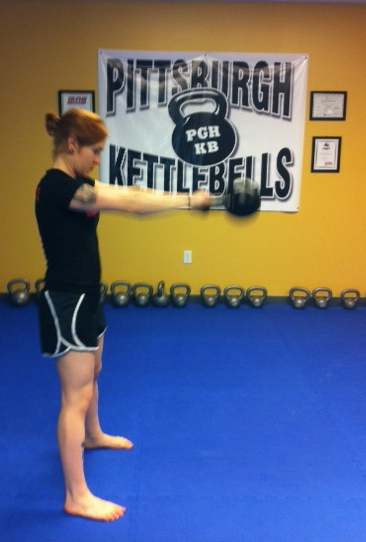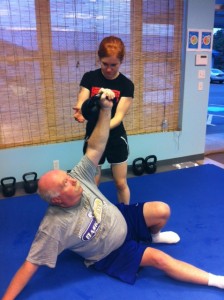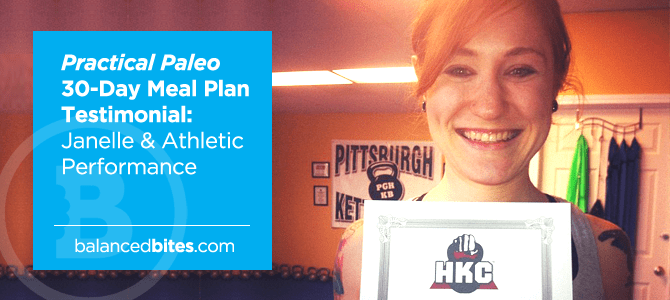How Practical Paleo enhanced my Athletic Performance
Janelle Pica | The Primal Burgher
My name is Janelle Pica and I am in love with all things kettlebell. Recently I became a level one certified instructor, which is known as the hard style Kettlebel certification through Dragon Door. I am currently training for my second level Russian Kettlebell Certification – known as the RKC certification.
Now, I say all that to make something very clear: I am a conditioned athlete who is into some demanding and very high volume workloads. My diet is a key factor when it comes to maintaining proper energy levels to fuel my workloads and my lifestyle must remain conducive to my training programs.
That shouldn’t sound like rocket science at all, especially if you’re a personal trainer or are into serious athletic training for your sport of choice. However, I found myself in an interesting situation just a few months ago that had me incredibly concerned about maintaining the ever increasing physical demands of my workouts that my coach was giving me for my certification.
In fact, I felt so bad I was worried about passing my entry level Hard Style certification. Period.
So… how did this all happen?
Once upon a time I went on vacation (of course, vacation for me means LOTS of kettleblls and LOTS of food), training with a friend of mine who happens to operate the amazing blog, giryagirl.com (Please, if you have the time. Check out Adrienne Harvey’s blog. There are some awesome fitness and food tips on that site that will help you if you’re like me, and are addicted to kettlebells and paleo eats).
While I was in Florida, I was able to get an average of 9 hours of sleep, I feasted all local food, and really kept active training to about 4 days a week. I had a fairly active vacation but it was pretty awesome considering the strength gains I experienced, not to mention the plethora of local, organic food in the North Orlando area. I kept a food log that week just to see how I was eating, and I can tell you that this 5’3’’ woman was able to pack down anywhere from 2,000 to 2,500 calories a day without a problem. No exaggeration here. I ate like a Queen and felt awesome because of it!
After my week off, I began my new training program designed by my trainer and began teaching at her studio to gain some experience for my entry level certification. I hate to admit this, but I got so busy that I began to fumble on my own stress management and eating patterns. Suddenly I couldn’t be bothered with fueling my workouts and my calorie intake when form the 2,000-2,500 down to 1600 to 1800 calories a day. After my vacation, I came back home and had a week off of training per the recommendations of my trainer here in Pittsburgh. I immediately returned to work and quickly found myself going form 9 hours of sleep to 6.5 to 7 hours if I was lucky. My caffeine consumption increased as I tried to manage my own blog and my work related duties.
For a seasoned athlete, I can tell you that eating between 1600-1800 calories just won’t cut it.
That is especially true when the way you train is centered upon metabolic conditioning. Your body becomes a machine, burning through calories at the speed of light (ok, may not that fast but you get the picture). It only took those two weeks for me to find myself sitting on the sidelines feeling tired, cranky, anxious and shaky.
It was the beginning of August and I came into a train session with my trainer. I told her I was feeling “funky in the head” and that I was having a hard time keeping up with my training volumes. Her first reaction was to ask me if I was eating enough. It never occurred to me that I was eating less at the time because I didn’t particularly feel hungry, so I brushed off the idea as if it were nothing. Another week went by and I felt worse.
I decided to take a look at my food logs and shot them off to another trainer friend of mine. The reaction yet again was “Hey, you’re not eating enough.” Of course, stubborn me decided this was all a bunch of bologna and went on training hard for the third week.
There I was, the middle of August with just a month let for my HKC cert, and I felt like I was going to collapse.

I remember doing a particular heavy lifting session and after a whopping 15 minutes, I felt light headed, weak, and so exhausted I could have fallen over. Not to mention the level of soreness I attempted to bust through my session was killing me. It hit me then, that I was on the verge of triggering too much inflammation due to inadequate food, sleep, and stress management. “Ok!” I thought, time to listen to everyone warning me about my diet and take a serious look at my diet and lifestyle.”
After comparing my food logs from Florida and my food logs when I came back to Pittsburgh, I realized that I wasn’t doing my body justice. I wasn’t eating enough, nor was I getting the sleep I needed to repair my body appropriately from my heavy workouts. Finally, I had become so busy and tied up with life’s increasing demands, I wasn’t managing my own stress the way that I was in Florida (granted, I was on vacation, but still. There are better ways to manage stress when you’re working by brushing it aside…which isn’t managing stress at all).
Then it hit me!
When I was in Florida I was reading “Practical Paleo” by Diane Sanfilippo and had actually done a book review for her. While I was writing up the review, I had actually taken some notes on the athletic performance dietary guidelines in the book itself, with the intentions of putting them into full force for my HKC certification.
Well then, I thought “no time like today to get started” I had one month left until my certification, and I decided to go as hardcore as humanly possible to make sure I was prepared for my entry level certification. No more brushing off the advice of my trainer friends, no more placing my sleep on the back burner, and definitely done with the whole not eating enough food issue. It was time to do everything I could to fuel my body to get through my certification.
So what changed?
First and foremost, I had to build in stress management into my daily life.
Realizing I was pushing myself too hard to meet with life’s ever increasing demands with training and my other projects, stress management became top priority. It may sound silly, but managing your stress actually helps fuel your workouts before you ever place a fork full of food in your mouth. Diane talks a lot about stress management as being crucial for your body to recover, and she is absolutely right.
I cut my caffeine to no more than two cups of coffee a day and made absolutely sure when I was sleeping, my room was dark as humanly possible. I live in the City of Pittsburgh so I actually did have to purchase some heavy duty black out shades to keep noise and city lights from shining into my bedroom. I also scheduled (yes, scheduled) time to relax during the day. Sometimes, all you need is 20 minutes when you get back from work to tune out and meditate to release all the days stress from your system. I found that breathing exercises helped with my training as I was more relaxed and ready for action to sustain more intense workouts. Neat!
Now, the second portion of this was my diet.
At first I thought that by doubling my protein and carbs would help sustain my workouts. Surprisingly, I found that by actually increasing my fats at each meal, I was able to have a constant stream of energy through the day and throughout my training.
Lesson learned: don’t be afraid of fat. Fat is your friend, and by increasing your fat intake, you’ll have more stable energy levels and better blood sugar control throughout the day.
EAT YOUR AVOCADOS! I averaged about 100-120 grams of carbohydrate, 120 to nearly 150 grams of fat (yes, you need that) and about 100-130 grams of protein on any given training day. Total calories thus ranged from about 2,100 to up around 2,500 depending on the intensity of my workloads. Now, I know that me saying “eat more” sounds like common sense, but I find that it is hard to gauge how much to eat at times, especially if you’re a paleo enthusiast like myself. A high protein and high fat diet will curb your appetite, so it is easier to under eat when your diet is paleo. The volume of food you will have to eat may even shock you, but you simply have to pack it down. I mean it! EAT UP!
There were a few tricks that were mentioned in “Practical Paleo” that I learned and put to some good use for myself as well.
This might sound strange, but I highly recommend that the hardcore athlete to pick up a supply of fermented cod liver oil (FCLO). This supplement is the best for cutting down inflammation. Within 4 days of consistent use, my post workout soreness that was killing me was almost negligible. Not only did I experience less muscle and joint stiffness, I also experienced increased mental alertness, an added bonus of a FCLO supplementation. Note from Diane: The CoQ-10 that is naturally occurring in the FCLO may also have played a big part in helping Janelle's recovery!
Better focus meant better training and better management of my daily tasks outside of my training.
Diane is not kidding with this. Get yourself some fermented cod-liver oil by Green Pastures and experience the benefits for yourself (side note: I am a fan of the cinnamon flavored version. YUM!). The last little tip I applied from Practical Paleo was actually cutting out post workout protein shakes and replacing them with a solid meal and a cup of bone broth after my workouts.
YEP! BONE BROTH!
Practical Paleo has an awesome recipes for bone broth, and this stuff is loaded with electrolytes that you need to replenish after your workout. Speaking form personal experience, I can honestly say that nothing made me feel as replenished as bone broth after a workout. Better recovery always means better training the next day. I like to prepare the bone broth ahead of time and freeze any left overs I have in an ice tray. That way, you can defrost the extra broth bit by bit when you’re ready to train hard.
Now, what were the results?
 My terrible head funk cleared in a matter of days, and I got right back into my heavy training within a week. My energy increased, my sleeping patterns regualted thsmelses (averaged about 8.5 to 9 hours a night) and my training volumes increased in intensity. In fact, I was able to perform a pretty demanding kettlebell snatch test using a 36 lb. kettlebell. 100 reps in 5 minutes. BOO YEAH!
My terrible head funk cleared in a matter of days, and I got right back into my heavy training within a week. My energy increased, my sleeping patterns regualted thsmelses (averaged about 8.5 to 9 hours a night) and my training volumes increased in intensity. In fact, I was able to perform a pretty demanding kettlebell snatch test using a 36 lb. kettlebell. 100 reps in 5 minutes. BOO YEAH!
I was happier throughout the day and the stress that was bogging me down seemed to miraculously disappear. Finally, I was able to pass my HKC certification with energy and ease when September finally rolled around. I made it, but it wouldn’t’ have been possible without the amazing resource from Diane Sanfilippo.
If you’re like me and are a paleo style athlete, please pay attention to the guidelines for athletic performance in Diane’s Book, Practical Paleo. It can be tricky at times to figure out how to properly fuel your workouts, especially when you’re a paleo dieter. I have found that a lot of athletes are actually underrating and not realizing it because of how a higher fat and protein load normally curbs your appetite. Don’t feel bad, it happens, but you’re going to want to address this issue before you get too lightheaded during a heavy lift session. Under eating slows your training, and it can be dangerous for your body if your calories sink too low. Also, it is incredibly easy to let your athletic attitude get the best of you, thinking you can handle anything and everything all at once and then negating your own deserved down time. DON’T LET THIS HAPPEN! You deserve to be rested for your work, your family, and your own training. You will find that the tips for stress management are all outlined for you in the book Practical Paleo. Take them and apply them immediately. Diane is a busy woman herself, and if she can do it, you can too!
I want to thank the amazing Diane Sanfilippo for the amazing work she put together in Practical Paleo.
The athletic performance section of her book helped a strong chick in training get even stronger, and anyone else out there will reap strength gains from Diane's tips as well.
As for me, I am off to certification number two in April, 2013. You can bet your butt that I will be eating smarter and training harder due to all the amazing tips I have learned from Practical Paleo. Don’t delay! Read this book and get after your fitness goals!
Thanks, Janelle, for your story!
Think Janelle looks familiar? That's because she was so excited when she got her copy of Practical Paleo that she made this video:
Have you been following one of the 30-Day Meal Plans in Practical Paleo? Want to share your story? Contact me to do so!
Stay tuned for more Practical Paleo 30-Day Meal Plan success stories soon!


Comments 13
Fermented cod liver oil vs regular? Just wondering the difference. I’m not a “top notch” athlete, but I do suffer mild ongoing soreness and wondering if this may help!
Indeed- the fermented is processed by a traditional method versus heat-processing. The only brand that I currently recommend is Green Pasture. I don’t know of any other cold-processed/naturally fermented options out there. I would also recommend getting extra CoQ10 into your diet (also available in the FCLO) via sardines, heart (if you’re so inclined), and red palm oil.
The link to the Green Pastures on Amazon is almost twice as expensive as other identical products on Amazon and over $20.00 more than the same product on the Green Pastures site.
Yeah, I recommend getting it directly from Green Pasture or from http://www.drrons.com whenever possible. The product prices vary a bit as well depending on which you get. It’s usually around $50-60 for the FCLO/BO blend in cinnamon gel I like best- which is currently sold out (I’m sure in part to how much we recommend it on our podcast/workshops/FB/etc!).
Thanks! I met up with our mutual friend, Chloe, last weekend, and among catching up on 11 years, we talked about your book (which we both love!). Congratulations on your success. Maybe I’ll run into you in NJ, if I ever commit to CrossFit! 🙂
I just saw that, and was wondering if there’s a difference between the product linked (for $66.95) and the one that looks really similar, if not identical (for $33, here http://www.amazon.com/Green-Pastures-Blue-Fermented-Liver/dp/B002LZYPS0/ref=pd_sim_hpc_1/182-4085118-6025026). Diane, do you have any thoughts on this?
Thanks so much for your story and advice!
That one is not the blend, and it’s capsules, not the gel. It’s different and less potent per dose– so you need more to get the same dose, hence why it’s cheaper.
Hi Diane, I’m exploring the Green Pasture site and I feel like I’m tumbling down a rabbit hole with all of the products that they offer. Are there any other nutritional supplements that you’d recommend as necessary, above the rest? The multi-vitamin perhaps, or the organ one? Thanks!!
I’d say to try anything that looks interesting to you from Green Pasture or http://www.drrons.com – I don’t have a lot that I recommend as a broad stroke, but I personally ordered some dessicated organ capsules after trying some from Liz (Cave Girl Eats) and after having supplemented with some previously for adrenal support and liking how they felt.
I always hear you and Liz talk about the cod liver/butter oil blend…but I only see it in capsules on the green pastures site. Does it come in the liquid cinnamon flavor form or only capsules? If it only comes in capsules, should I get them or or would you recommend getting the straight cod liver oil liquid cinnamon flavor? Thanks for all you do, love the book, blog, and podcasts! Keep them coming!
The cinnamon gel is currently sold out. They take it down from the site when this happens I guess versus marking it sold out!
Would you recommend getting the capsules for now until they get the gel back in? I’m currently just using regular fish oil capsules 2gm/day.
how do you measure the nutritional content of your bone broth?